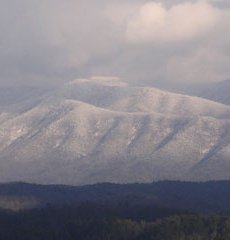

Hemlock
Oak
Maple
Poplar
Rhododendron
Mountain Laurel
Galax
Morel Mushrooms
Pinksters
Ladies Slipper Orchids
Trillium
via Gold Mine Trail & Cooper Road
Cades Cove - 10 Miles
Gregory's Bald - 22 Miles
Abram's Creek - 5 Miles
School House Gap 1.2 Miles
Thunder Head - 20 Miles
Mt. LeConte
Clingman's Dome
Thunder Head
Rocky Top
Gregory's Bald
Ft. Loudon Electric Cooperative
Designed and tested to
insure no contamination
Well required to provide water.
Quantity and quality has been
excellent from existing wells.
Cades Cove |
Cades Cove, a fertile elliptical valley surrounded on all sides by the Great Smoky Mountains, had already been long inhabited by the Cherokees, who called it Tsiyahi, or "otter place," when John Oliver, his wife, and young child arrived there in the fall of 1818. By 1821 other neighbors had joined the Olivers from Carter County, and the expansion of farms, homes, and gardens proceeded rapidly in a pattern identical to frontier development throughout the United States. As early as 1827 a bloomery forge had been constructed in the cove; by the 1830s roads for marketing agricultural surplus connected the cove to Maryville and Knoxville. In the 1840s and 1850s new waves of immigrants from other states and many foreign countries entered the cove, enriching the community with their diverse talents. Although many migrants used the cove only as a temporary way station in their travel west, entrepreneurs like Daniel D. Foute and abolitionist, mineralogist, and physician Dr. Calvin Post surveyed the surrounding mountains for prospective gold and copper mines in a fever of capitalist activity. Because of its unique location, Cades Cove remained a community of farms surrounded by large stretches of mountain wilderness, an environment which provided plentiful opportunities for hunting deer and bear and fur trapping. Prior to 1819, Cades Cove was part of the Cherokee Nation. The Cherokee called the cove Tsiyahi, "place of the river otter." In addition to river otters, elk and eastern bison lived in the Cove. Most large animals were extirpated before white settlement. The Cherokee tried to integrate European technologies and culture with their own. They built log and frame houses, attended school and by 1820 had a written language. The 1830 U.S. census showed more than 1,000 slaves working on Cherokee plantations. Despite the Cherokee's lifestyle, many Americans wanted to move all Indians west of the Mississippi River. The discovery of gold on Cherokee lands in Georgia, and Andrew Jackson's rise to the Presidency, led to Indian removal and the tragic "Trail of Tears." More than 14,000 Cherokees left the Southern Appalachians in 1838. Less than 10,000 reached Oklahoma. Some of the Cherokee refused to move and hid in the Smoky Mountain wilderness. In the 1870s the Eastern Band of the Cherokee reclaimed some of their lands in western North Carolina. This land is known today as the Qualla Boundary. By 1850 the American population of Cades Cove reached 685 men, women, and children. Settlers farmed the rich fertile limestone-based soils, shopped at local general stores, and made frequent trips to nearby Tuckaleechee Cove, now Townsend, TN. With five roads in and out of the cove, the settlers were not as isolated as the cove appears today. The majority of Cades Cove residents supported the United States during the Civil War. Harassed by their confederate neighbors, cove families welcomed the end of the war and a return to their rural lifestyle. Churches and schools provided a social and spiritual education to young and old alike. Sacred Harp singing schools attracted hundreds of outsiders to the cove each year and many cove residents sent their children to colleges in communities outside the cove. But America was expanding westward, and the cove population never recovered its pre-war growth and numbers. In 1900 the logging industry brought wage employment and added income to the mountain people. Alcoa opened its first factories in nearby Maryville, TN, and more and more people began to leave the area. The establishment of the Great Smoky Mountains National Park (see Park Creation) continued the outward migration from the Cove that ended in 1999 when the last resident, Kermit Caughron, died. For more information about Cades Cove please refer to the Great Smoky Mountain Association's publications. For More Information, Contact: Voice: |